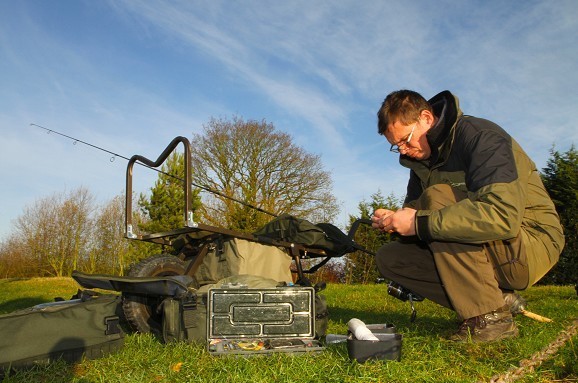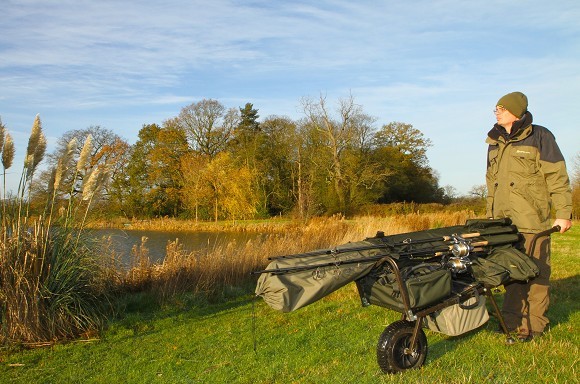
Scaling down
Jon ‘Shoes’ Jones reveals how scaling your gear down could allow you to catch more carp this winter
At this time of year, as the temperature plummets, the carp feed with little gusto and the fishing on lakes up and down the country tends to slow down. Rather than spending days on the bank, I tend to put the bivvy and bedchair in the garage, preferring to fish short day sessions on local waters. Regardless of the time of year, travelling light and moving onto showing fish will catch you lots more fish. But, in the winter, when the carp are a lot less active, it’s more important than ever to be mobile.
The carp don’t move very much and can spend prolonged periods shoaled up together in large groups. If you can find where the carp are holding-up and put a hookbait near them, you can usually nick a few bites. But, in order to find where they are holding, you need to keep your eyes peeled and be ready to move swims in an instant. A couple of bubbles or a small swirl can reveal whereabouts of the lake’s residents. Once you’ve found where they are holding, there’s a good chance that they will spend the majority of the winter in the same place. If you don’t see signs of carp, it’s well worth moving swims on a regular basis.
In order to fish effectively during the colder months, it’s imperative that we scale everything down. It’s hard work moving swims, especially if you take loads of tackle with you. If we’re honest, we probably all take too much gear with us. Over the course of the year, it’s easy to fill your tackle bag with a whole host of bits that you rarely use. So, as soon as the colder weather sets in, I spend a couple of hours sorting my gear and scaling everything right down. Remember, the less gear you take, the more chance there is that you will move if you see carp showing elsewhere.
My Main Bag
My main aim is to fit all my tackle, brew kit and bait into one small bag. I’ve used a variety of different tackle bags over the years but the Avid Carp Transit 3 Bag is my first choice all-year round. The bag is great because it consists of two halves. Once it’s open, you can see all of your tackle items and get to everything easily. Plus, you can split the bag in half using the speed clips. Although the bag was designed so that it could be separated to fit under your bedchair, it’s great if you’re looking to cut all your gear down. Instead of buying a smaller bag, you can split your larger bag in two.
As a rule, I put all my bits for day sessions into one half of the bag and my bits for overnight sessions in the other. This means I can just unzip the bag when I arrive at the lake, depending on the length of the session that I’m planning to do. I’d advise that you use a small bag that doesn’t take up much room on your barrow. If you use a big bag, you may find yourself filling it with bits that you won’t use just because you can.
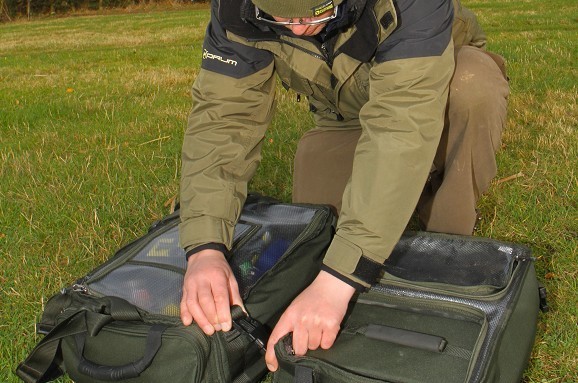
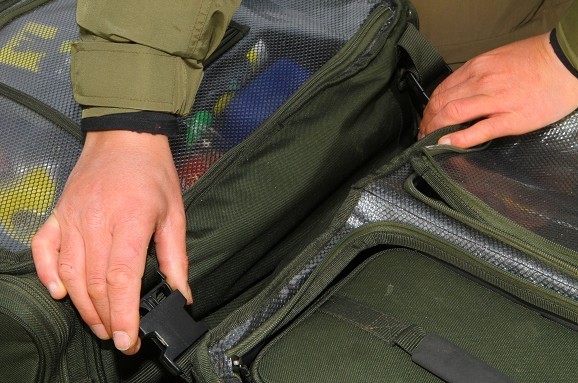
The Terminal Tackle
With a bag sorted, it’s time to start scaling all of your tackle down. If you look through your tackle bag now, you will probably discover loads of bits that you haven’t used for months. One half of the Avid Carp Transit 3 boasts two large internal pockets, so I aim to fit all of my terminal tackle into one half and my bait in the other.
Firstly, I put all of my terminal tackle bits inside an Avid Carp Tackle Pouch. Hooks, hooklink material, baiting tools and boilie stops are all crammed into this compact bag. If it doesn’t fit in and I don’t think it’s essential, I won’t take it. Don’t fall into the trap of taking bits for the sake of it because you’ve got room. The more stuff you take, the heavier the bag will be and the harder it will be to find your bits.
To keep all my smaller bits organised, I use two Korum Compartment Boxes inside the pouch. These contain things like rig rigs, shrink tubing and swivels. I try to limit myself to a couple of packets of hooks that will allow me to fish a variety of different presentations. When it comes to hooklink, I usually take a spool of coated braid, some supple braid and some material for Zig Rigs.
I store all of my leads and PVA in an Avid Carp Lead Pouch. My biggest tip is to only take a selection of leads with you. Leads weigh a lot, obviously, so taking loads with you defeats the whole object of travelling light. Rather than taking lots of leads, I just take a selection of different shapes and sizes. When it comes to PVA, I take a variety of solid bags and some PVA tape for stringers. I also take a small rig pouch with me that contains a selection of different of rigs that I’ve tied before the session. This allows me to get the rods out quickly and effectively as soon as I get to the lake. Plus, if you tie a selection of different rigs at home, you can afford to take less terminal tackle.
The great thing about all of the Avid Carp luggage bits is that they all fit neatly inside the Avid Transit 3 Carryall. This means that your bag will be a lot more organised, allowing you to fit more gear into it.
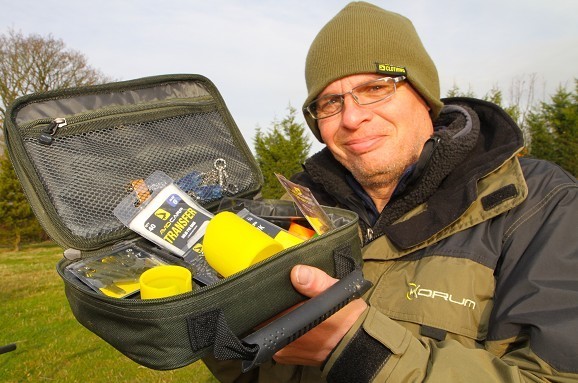
The Brew Kit
If you want to travel super-light, you can always leave your kettle and stove at home. If I’m honest though, I don’t think that I could function without a couple of cups of tea throughout the day. Personally, I take a Coleman stove, kettle and a small tub containing tea bags and sugar. When it’s bitterly cold, it’s essential that you try and keep as warm as possible. Hot drinks will keep you warm and ensure that you fish more effectively throughout the day. A cold angler will be less inclined to move and will end up going home much sooner that anticipated.
Bait For Mobile Fishing
With the tackle and brew kit sorted, it’s time to take a look at the bait that I take. On short sessions, during the winter, I’ll either fish small solid bags, stringers or single hookbaits. Therefore, there’s no need to take loads of bait. All I take is a few tubs of pop-ups, a tub of low-oil pellets and a few handfuls of boilies. Every angler is guilty of taking too many pop-ups with them, so I narrow mine down to just two tubs. Let’s be honest, we all have a favourite flavour that we tend to stick with on every session anyway.
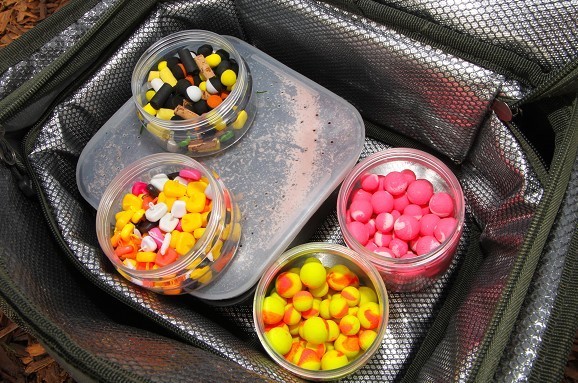
The Rest Of The Kit
With all your tackle and bait stored in a compact bag, it’s time to look at the other tackle that you’re going to take with you and, more importantly, what you should leave at home. If I’m just fishing a short session, I will leave my spod and marker rod at home. Most of the time I will probably just be chucking small bags and single hookbaits around the lake in a bid to nick a few bites. Casting a marker rod or spod into the lake can often ruin your chances of a bite before you’ve even got a hookbait into the lake.
Although there are a whole host of rod systems on the market, I cannot fault my Avid Carp Transit Quiver. It allows me to pack my rods away quickly and will house my landing net and my Alpine 60in brolly. If you’re hardcore, you can leave the brolly at home and just get yourself some decent waterproof clothing. I prefer to use the brolly because it can be thrown up in a matter of seconds and will shelter you from the wind and rain. It’s super-sturdy and due to its built-in stability poles, you don’t need to peg it down.
Over the years I’ve seen anglers using bivvies on day sessions. To be honest, I’d rather not take one with me. They’re often heavy and will take a lot longer to pack away should you need to move. For me, there’s no better shelter than a 60in oval brolly.
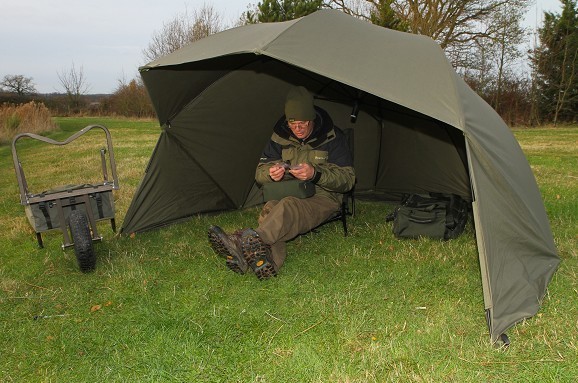
Carp Care Products
So, with your rod, shelter, terminal tackle and bait sorted, it’s time to take a look at your carp care items. I prefer to use a conventional unhooking mat because they pack away on the barrow nicely. I usually fold my scales, weigh sling and carp care kit between the unhooking mat and place it at the bottom of my barrow.
If, like me, you scale all your gear down this winter you will definitely catch more carp. Anglers that move regularly will catch more carp than anglers that don’t. If you stay mobile, keep your wits about you, there’s no need to spend days on the bank. You can often plunder the water during a short session, while other anglers spend days on the bank with little or no action.
